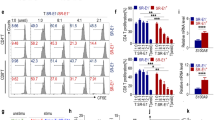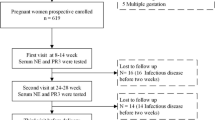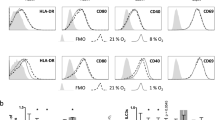Abstract
Dietary l-proline (proline) supplementation during gestation enhances fetal survival and placental development in mice. The objective of the present study was to test the hypothesis that this beneficial effect of proline was associated with alterations in inflammatory response at the placenta and fetus interface. Populations of immune cells present in peripheral blood mononuclear cells (PBMC) were determined by flow cytometry analysis. The concentrations of immunoglobulins in plasma, and the concentrations of cytokines in plasma, uterus, placenta, and amniotic fluid were measured using a bead-based immunoassay. The data showed that proline supplementation led to higher (P < 0.05) populations of B lymphocytes (CD3−CD19+), natural killer (NK) cells (CD3−NK1.1+), and dendritic cells (DCs, CD11c+MHCII+) in peripheral blood, as compared with the controls. Conversely, mice fed a proline-supplemented diet had a lower population of neutrophils (CD11b+F4/80−). Further study showed that proline supplementation decreased (P < 0.05) the concentrations of (1) interleukin (IL)-23, IL-1α, and IL-6 in plasma; (2) IL-6 in the uterus; and (3) tumor necrosis factor alpha (TNF-α), monocyte chemotactic protein (MCP)-1, and IL-17 in the placenta; and (4) interferon (IFN)-γ in amniotic fluid, compared with controls. Conversely, proline supplementation resulted in higher (P < 0.05) concentrations of (1) IL-10, IL-17 and granulocyte–macrophage colony-stimulating factor (GM-CSF) in plasma; (2) IL-10 and IL-1α in the uterus; and (3) IL-1α, IL-1β, IL-10, IL-27, and IFN-β in amniotic fluid, compared with controls. Moreover, concentrations of immunoglobulin (Ig) G2b and IgM were enhanced (P < 0.05) by proline administration. Taken together, our results reveal a regulatory effect of proline in the immunological response at the maternal–fetal interface, which is critical for embryonic development and fetal survival.






Similar content being viewed by others
Abbreviations
- APC:
-
Allophycocyanin conjugated
- DCs:
-
Dendritic cells
- E:
-
Embryonic day
- FITC:
-
Fluorescein isothiocyanate-conjugated
- GM-CSF:
-
Granulocyte–macrophage colony-stimulating factor
- IFN:
-
Interferon
- Ig:
-
Immunoglobulin
- IL:
-
Interleukin
- MCP-1:
-
Monocyte chemotactic protein 1
- MHC:
-
Major histocompatibility complex
- NK:
-
Natural killer
- PBMC:
-
Peripheral blood mononuclear cells
- PE:
-
Phycoerythrin
- PerCP:
-
Peridinin chlorophyll protein complex-conjugated
- Proline:
-
L-Proline
- RBC:
-
Red blood cell
- TNF-α:
-
Tumor necrosis factor alpha
- Th:
-
T helper
- Treg:
-
Regulatory T
References
Ashkar AA, Croy BA (2001) Functions of uterine natural killer cells are mediated by interferon gamma production during murine pregnancy. Semin Immunol 13:235–241
Ashkar AA, Di Santo JP, Croy BA (2000) Interferon gamma contributes to initiation of uterine vascular modification, decidual integrity, and uterine natural killer cell maturation during normal murine pregnancy. J Exp Med 192:259–270
Ashmore LM, Shopp GM, Edwards BS (1989) Lymphocyte subset analysis by flow cytometry. Comparison of three different staining techniques and effects of blood storage. J Immunol Methods 118:209–215
Bartmann C, Segerer SE, Rieger L et al (2014) Quantification of the predominant immune cell populations in decidua throughout human pregnancy. Am J Reprod Immunol 71:109–119
Bazer FW, Burghardt RC, Johnson GA et al (2018) Mechanisms for the establishment and maintenance of pregnancy: synergies from scientific collaborations. Biol Reprod 99:225–241
Correale J, Villa A (2004) The neuroprotective role of inflammation in nervous system injuries. J Neurol 251:1304–1316
De Rosa SC, Herzenberg LA, Herzenberg LA et al (2001) 11-color, 13-parameter flow cytometry: identification of human naive T cells by phenotype, function, and T-cell receptor diversity. Nat Med 7:245–248
Dimac-Stohl KA, Davies CS, Grebe NM et al (2018) Incidence and biomarkers of pregnancy, spontaneous abortion, and neonatal loss during an environmental stressor: Implications for female reproductive suppression in the cooperatively breeding meerkat. Physiol Behav 193:90–100
Dosiou C, Giudice LC (2005) Natural killer cells in pregnancy and recurrent pregnancy loss: endocrine and immunologic perspectives. Endocr Rev 26:44–62
Ernerudh J, Berg G, Mjosberg J (2011) Regulatory T helper cells in pregnancy and their roles in systemic versus local immune tolerance. Am J Reprod Immunol 66(Suppl 1):31–43
Feyaerts D, Benner M, van Cranenbroek B et al (2017) Human uterine lymphocytes acquire a more experienced and tolerogenic phenotype during pregnancy. Sci Rep 7:2884
Fu B, Zhou Y, Ni X et al (2017) Natural killer cells promote fetal development through the secretion of growth-promoting factors. Immunity 47(1100–1113):e1106
Gao K, Jiang Z, Lin Y et al (2012) Dietary l-arginine supplementation enhances placental growth and reproductive performance in sows. Amino Acids 42:2207–2214
Gelber SE, Brent E, Redecha P et al (2015) Prevention of defective placentation and pregnancy loss by blocking innate immune pathways in a syngeneic model of placental insufficiency. J Immunol 195:1129–1138
Herring CM, Bazer FW, Johnson GA et al (2018) Impacts of maternal dietary protein intake on fetal survival, growth, and development. Exp Biol Med (Maywood) 243:525–533
Higuma-Myojo S, Sasaki Y, Miyazaki S et al (2005) Cytokine profile of natural killer cells in early human pregnancy. Am J Reprod Immunol 54:21–29
Hou YQ, He WL, Hu SD, Wu G (2019) Composition of polyamines and amino acids in plant-source foods for human consumption. Amino Acids 51:1153–1165
Kieckbusch J, Gaynor LM, Moffett A et al (2014) MHC-dependent inhibition of uterine NK cells impedes fetal growth and decidual vascular remodelling. Nat Commun 5:3359
Kwan STC, King JH, Yan J et al (2017) Maternal choline supplementation during murine pregnancy modulates placental markers of inflammation, apoptosis and vascularization in a fetal sex-dependent manner. Placenta 53:57–65
Lash GE, Robson SC, Bulmer JN (2010) Review: Functional role of uterine natural killer (uNK) cells in human early pregnancy decidua. Placenta 31(Suppl):S87–92
Lashley LE, van der Hoorn ML, van der Mast BJ et al (2011) Changes in cytokine production and composition of peripheral blood leukocytes during pregnancy are not associated with a difference in the proliferative immune response to the fetus. Hum Immunol 72:805–811
Li P, Wu G (2018) Roles of dietary glycine, proline and hydroxyproline in collagen synthesis and animal growth. Amino Acids 50:29–38
Li P, Wu G (2020) Composition of amino acids and related nitrogenous nutrients in feedstuffs for animal diets. Amino Acids. https://doi.org/10.1007/s00726-020-02833-4
Li XL, Rezaei R, Li P, Wu G (2011) Composition of amino acids in feed ingredients for animal diets. Amino Acids 40:1159–1168
Li X, Bazer FW, Johnson GA et al (2014) Dietary supplementation with l-arginine between days 14 and 25 of gestation enhances embryonic development and survival in gilts. Amino Acids 46:375–384
Liu HY, Liu ZK, Chao H et al (2014) High-dose interferon-gamma promotes abortion in mice by suppressing Treg and Th17 polarization. J Interferon Cytokine Res 34:394–403
Liu X, Pan S, Li X et al (2015) Maternal low-protein diet affects myostatin signaling and protein synthesis in skeletal muscle of offspring piglets at weaning stage. Eur J Nutr 54:971–979
Liu N, Dai Z, Zhang Y et al (2019) Maternal l-proline supplementation enhances fetal survival, placental development and nutrient transport in mice. Biol Reprod 100:1073–1081
Moinard C, Cynober L, de Bandt JP (2005) Polyamines: metabolism and implications in human diseases. Clin Nutr 24:184–197
Murphy VE, Smith R, Giles WB et al (2006) Endocrine regulation of human fetal growth: the role of the mother, placenta, and fetus. Endocr Rev 27:141–169
Nybo Andersen AM, Wohlfahrt J, Christens P et al (2000) Maternal age and fetal loss: population based register linkage study. BMJ 320:1708–1712
Pacheco R, Gallart T, Lluis C et al (2007) Role of glutamate on T-cell mediated immunity. J Neuroimmunol 185:9–19
Pazos M, Sperling RS, Moran TM et al (2012) The influence of pregnancy on systemic immunity. Immunol Res 54:254–261
Perricone R, De Carolis C, Giacomelli R et al (2003) GM-CSF and pregnancy: evidence of significantly reduced blood concentrations in unexplained recurrent abortion efficiently reverted by intravenous immunoglobulin treatment. Am J Reprod Immunol 50:232–237
Piccinni MP, Giudizi MG, Biagiotti R et al (1995) Progesterone favors the development of human T-helper cells producing Th2-type cytokines and promotes both Il-4 production and membrane Cd30 expression in established Th1 cell clones. J Immunol 155:128–133
Plaks V, Birnberg T, Berkutzki T et al (2008) Uterine DCs are crucial for decidua formation during embryo implantation in mice. J Clin Invest 118:3954–3965
Popovic PJ, Zeh HJ 3rd, Ochoa JB (1686S) Arginine and immunity. J Nutr 137:1681S–1686S
PrabhuDas M, Bonney E, Caron K et al (2015) Immune mechanisms at the maternal-fetal interface: perspectives and challenges. Nat Immunol 16:328–334
Robertson SA (2007) GM-CSF regulation of embryo development and pregnancy. Cytokine Growth Factor Rev 18:287–298
Robertson SA, Chin PY, Femia JG et al (2018) Embryotoxic cytokines-potential roles in embryo loss and fetal programming. J Reprod Immunol 125:80–88
Rosario FJ, Jansson N, Kanai Y et al (2011) Maternal protein restriction in the rat inhibits placental insulin, mTOR, and STAT3 signaling and down-regulates placental amino acid transporters. Endocrinology 152:1119–1129
Rozner AE, Durning M, Kropp J et al (2016) Macrophages modulate the growth and differentiation of rhesus monkey embryonic trophoblasts. Am J Reprod Immunol 76:364–375
Saito S, Nakashima A, Shima T et al (2010) Th1/Th2/Th17 and regulatory T-cell paradigm in pregnancy. Am J Reprod Immunol 63:601–610
Stavnezer J (1996) Immunoglobulin class switching. Curr Opin Immunol 8:199–205
Svensson-Arvelund J, Ernerudh J (2015) The role of macrophages in promoting and maintaining homeostasis at the fetal-maternal interface. Am J Reprod Immunol 74:100–109
Svensson-Arvelund J, Mehta RB, Lindau R et al (2015) The human fetal placenta promotes tolerance against the semiallogeneic fetus by inducing regulatory T cells and homeostatic M2 macrophages. J Immunol 194:1534–1544
Thiele K, Diao L, Arck PC (2018) Immunometabolism, pregnancy, and nutrition. Semin Immunopathol 40:157–174
Wallrapp A, Riesenfeld SJ, Burkett PR et al (2017) The neuropeptide NMU amplifies ILC2-driven allergic lung inflammation. Nature 549:351–356
Wu G (1997) Synthesis of citrulline and arginine from proline in enterocytes of postnatal pigs. Am J Physiol 272:G1382–G1390
Wu G (2018) Principles of animal nutrition. CRC Press, Boca Raton
Wu G, Flynn NE, Knabe DA (2000) Enhanced intestinal synthesis of polyamines from proline in cortisol-treated piglets. Am J Physiol 279:E395–E402
Wu G, Bazer FW, Cudd TA et al (2004) Maternal nutrition and fetal development. J Nutr 134:2169–2172
Wu G, Bazer FW, Hu J et al (2005) Polyamine synthesis from proline in the developing porcine placenta. Biol Reprod 72:842–850
Wu G, Bazer FW, Wallace JM, Spencer TE (2006) Intrauterine growth retardation: implications for the animal sciences. J Anim Sci 84:2316–2337
Wu G, Bazer FW, Davis TA et al (2007) Important roles for the arginine family of amino acids in swine nutrition and production. Livest Sci 112:8–22
Wu G, Bazer FW, Burghardt RC et al (2011) Proline and hydroxyproline metabolism: implications for animal and human nutrition. Amino Acids 40:1053–1063
Wu G, Bazer FW, Satterfield MC et al (2013) Impacts of arginine nutrition on embryonic and fetal development in mammals. Amino Acids 45:241–256
Wu G, Bazer FW, Johnson GA et al (2017) Functional amino acids in the development of the pig placenta. Mol Reprod Dev 84:870–882
Yockey LJ, Iwasaki A (2018) Interferons and proinflammatory cytokines in pregnancy and fetal development. Immunity 49:397–412
Zhang Y, Jiang N, Zhang T et al (2018) Toxoplasma gondii genotype determines tim-3 expression levels in splenic and circulatory T cells in mice. Front Microbiol 9:2967
Acknowledgements
This work was supported by the National Natural Science Foundation of China (Nos. 31572410, 31572412, 31625025), the Zhengzhou 1125 Talent Program, Jinxinnong Animal Science Development Foundation, 111 project (B16044), and Texas A&M AgriLife Research (H-8200).
Author information
Authors and Affiliations
Corresponding authors
Ethics declarations
Conflict of interest
The authors declare no competing financial interest.
Ethical approval
This animal study was approved by the Animal Use and Care Committee of China Agricultural University.
Additional information
Handling Editor: F. Blachier.
Publisher's Note
Springer Nature remains neutral with regard to jurisdictional claims in published maps and institutional affiliations.
Electronic supplementary material
Below is the link to the electronic supplementary material.
Rights and permissions
About this article
Cite this article
Liu, N., Chen, J., He, Y. et al. Effects of maternal l-proline supplementation on inflammatory cytokines at the placenta and fetus interface of mice. Amino Acids 52, 587–596 (2020). https://doi.org/10.1007/s00726-020-02837-0
Received:
Accepted:
Published:
Issue Date:
DOI: https://doi.org/10.1007/s00726-020-02837-0




